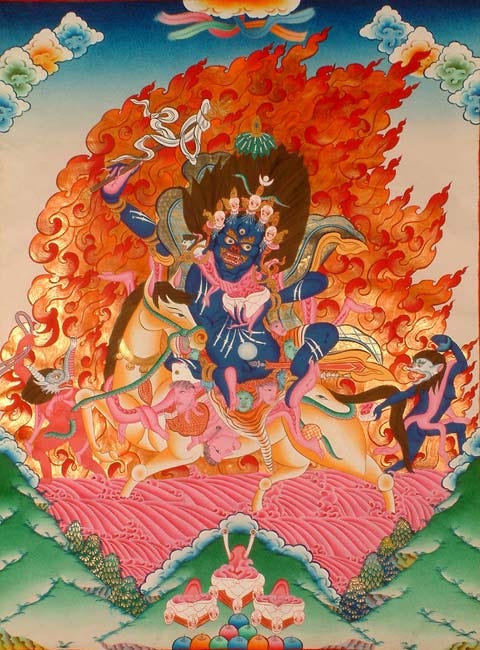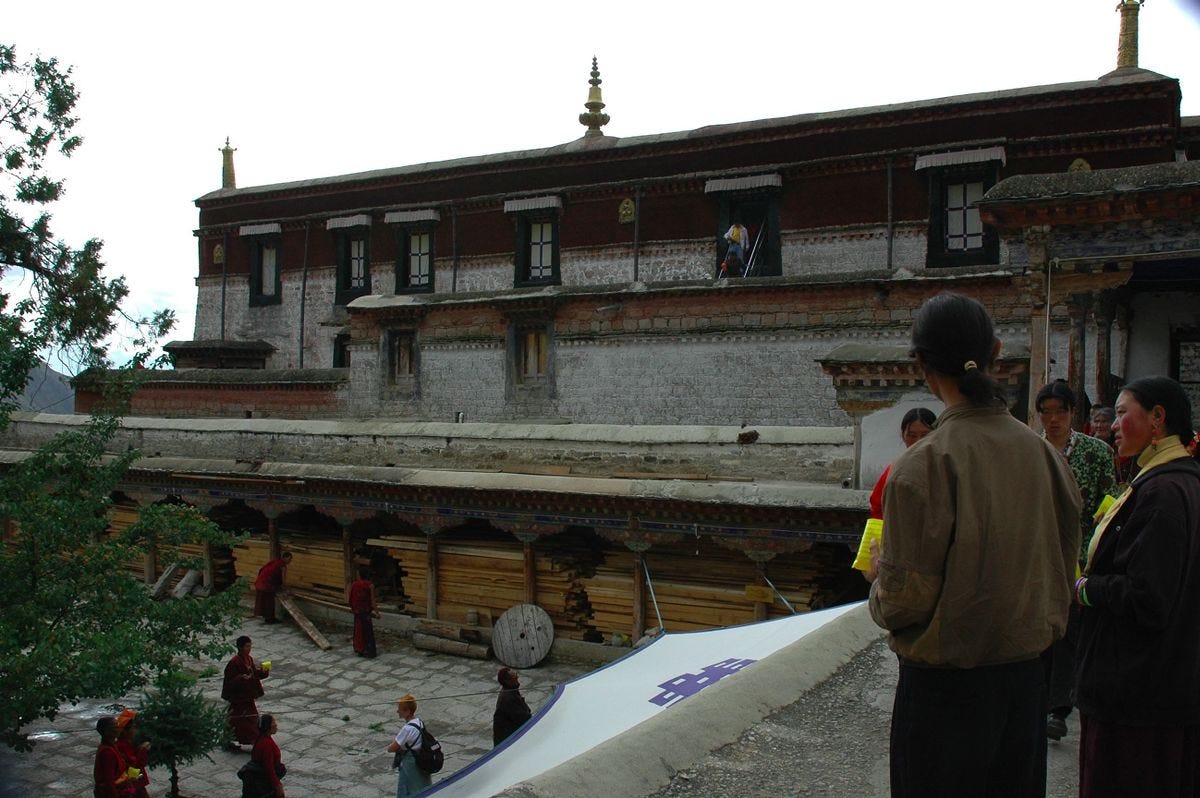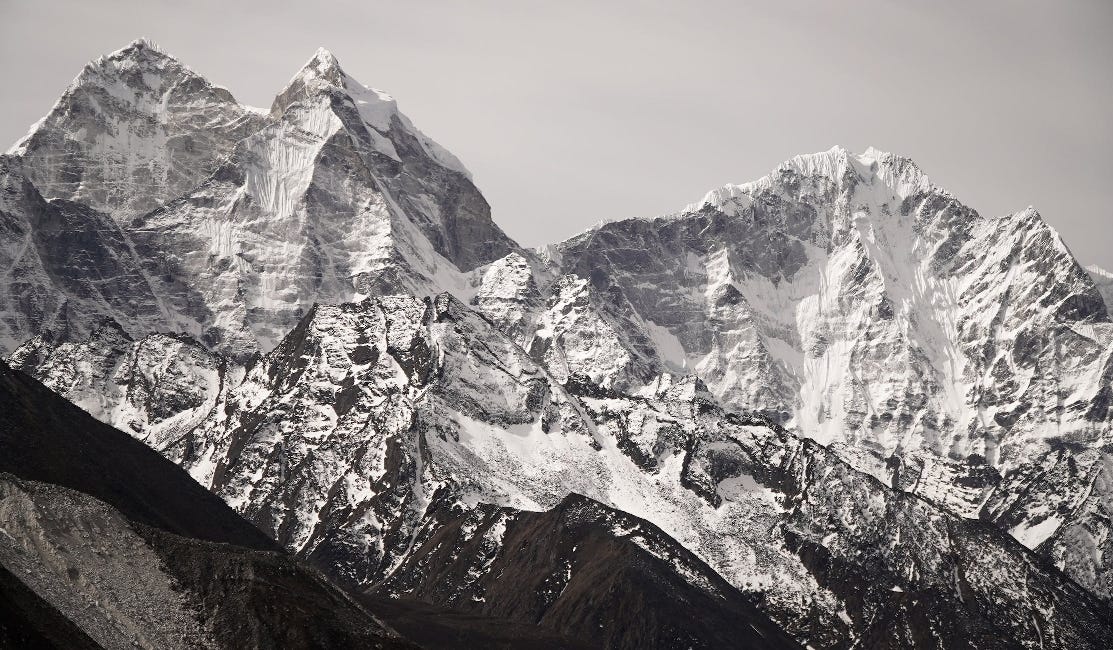Those who would first become Dalai Lama
**I apologize in advance for any transliteration errors. I will work to improve them. For text in parentheses, I tried to remain true to the Wylie system. Hard-copy-only sources are cited in footnotes. All others are cited with underlines indicating hyperlinks.
Palden Lhamo, the female guardian spirit of the sacred lake, Lhamo La-tso, and protector of the lineage of the Dalai Lamas (public domain image).
A young lad named Pema Dorje sat in candlelight studying Buddhist scriptures and commentaries by legendary Indian and Tibetan masters. Nartang Khenchen Drupa Sherab, who oversaw the boy’s progress, recognized his scholarship and devotion, offering him his novice vows in his mid-teens. Pema Dorje took the name Gendün Drupa upon becoming a fully ordained monk in 1410 or 1411; by then he was twenty years old.
Just a few years later, he met Tsongkhapa. It is hard to put into words what it must have been like to acquaint with such a figure. Having traveled to central Tibet from Amdo, Tsongkhapa gained his fame and status studying under highly-regarded figures of the time, such as Rendawa Zhönnu Lodrö, Choje Dhondrup Rinchen of the Jakjyung Monastery, and Chenga Chokyi Gyalpo, the head of the Drigungpa sect, among many others.
Tsongkhapa is regarded as an emanation of Manjushri—the bodhisattva of wisdom—and wrote prolifically, some 20 volumes encompassing 210 treatises. Perhaps his most important achievement in the annals of Tibetan history, he founded the Gelukpa School. This fortuitous introduction led to Gendün Drupa becoming Tsongkhapa’s disciple.
Under the tutelage of such a great teacher, Gendün Drupa traveled to Shigatse to found the Tashi Lhünpo (‘Mount Luck’) monastery in 1447. The establishment of a major Geluk center of learning in Shigatse would have a considerable impact on the unfolding of events in the coming centuries.
Shigatse, after all, was the capital of Tsang, and thus a seat of power of the Rinpungpa family, patrons of the Karma Kagyu School, an eventual rival to the Gelukpa School. While at Tashi Lhünpo monastery, Gendün Drupa wrote at least eight books on the Buddha’s teachings and philosophy. He died in 1474 at the age of 84. Gendün Drupa would be posthumously named the 1st Dalai Lama.
In 1475, Kunga Gyaltsen fathered a child he named Gendün Gyatso. The child Gendün, his mother Machik Kunga Pemo, and father Kunga resided on a small farm near Shigatse. Gendün Gyatso was named as the reincarnation of Gendün Drupa at Tashi Lhünpo monastery at age 11.
He later served as abbot of the monastery for several years, but a schism formed between two camps about how leadership of this critical institution should be chosen. One side wanted to select by meritocratic principles, while the other thought it should progress through reincarnated lineage. Gendün Gyatso decided to leave the monastery in the midst of this dispute, ultimately ending up at another formidable place, Drepung monastery.1
Located near Lhasa, Drepung and Sera monasteries suffered some oppression at the hand of the Rinpungpa regime at the very end of the 15th century. In 1498, for example, Gelukpa monks were forbidden from attending the Great Prayer Festival2 commemorating the New Year, and were assigned yellow hats (in contrast to the Kagyu’s red) as a means of readily identifying them.
According to Matthew Kapstein, this discrimination had more to do with the patron relationship between the Gelukpas and the Pakmodrupa, the Rinpungpa’s political rivals, than it did with philosophical or doctrinal differences.3
Gendün Gyatso’s closeness with the Pakmodrupa authority at Neudong would provide the foundation and funding for perhaps the most iconic construction project to occur in Tibet to that time—the building of the Ganden Palace (Phodrang). The palace would remain Gendün Gyatso’s home to the end of his life in 1542. Before he passed, he bequeathed upon his disciples this wisdom:
All of us who are friends; Are held together by fragile links; Like clouds in a wintry sky. Impermanent things know no stability; And are like an illusory mirage. Rely therefore on spiritual practice; The only stable force in a world of change. This is my advice to you; you should try always to live by it.4
The Ganden Palace. Source: Mandala Collections; photo by Natasha Judson; CC BY-NC 4.0 Deed
About a year after Gyatso’s death, a local governor in central Tibet had a son named Sonam Gyatso. At four years old, young Sonam took the throne in the Ganden Phodrang becoming a leading teacher of Buddhism by his early twenties.5 Another key figure flourished during this time. Altan Khan, the ruler of the Tümed Mongols and 20 years Sonam’s senior, invited the young leader to his court in Kokonor around 1578.
An adept military and political leader, Altan Khan had previously won concessions from the Ming Dynasty in China, reinvigorating Mongol expansion desires and empowering Buddhist missionaries active among various Mongol factions. The internal politics of the Mongols that led Altan Khan into a spiritual and political relationship with the Gelukpa were complex. One element may have had to do with Altan Khan’s desire not to be beholden to priests with close ties to Beijing, a nod toward his wish to strengthen Mongol autonomy from China.6
Whatever the case, Altan Khan became endeared with Sonam Gyatso, who drew Altan Khan’s people into the Geluk tradition.7 The closeness of their spiritual bond led to the creation by the Khan of the now epochal title, Dalai Lama—dalai in Mongolian meaning “ocean.” In return, Sonam Gyatso labeled the Khan the “King of the Dharma, Brahma among the Gods.”8 From then, Sonam Gyatso became the 3rd Dalai Lama, with Gendün Drupa and Gendün Gyatso named the first and second, respectively.
The 3rd Dalai Lama did not involve himself much in domestic politics. Instead, in 1583 or ‘84, he traveled to Tsongkhapa’s birthplace where he founded a new school at Kumbum monastery. The school would go on to educate many important missionaries and teachers over the next centuries.
Sonam Gyatso traveled to several more places, establishing more schools, including ones centered on translation especially near to the Chinese border. His reputation earned him an invitation to the Ming court by the Wanli (Shenzong) emperor in 1588, but he died before making the trip.
Sonam Gyatso holds the distinction of the first Dalai Lama recognized as such during his lifetime. Following him, 11 more Dalai Lamas would be born, some of them establishing their own profound legacies that played critical roles in Tibetan Buddhism and politics.
In Closing
In popular circles, the title Dalai Lama invokes images of only one—Tenzin Gyatso, the Fourteenth. This is of no surprise; the Dalai Lamas preceding him lived before most people outside of Asia even knew of such a place called Tibet.
Even after the Chinese invasion of Tibet following Mao Zedong’s rise to power, the land remained little more than a place of fantasy and myth to Westerners—a Shangri la, or enchanted Land of Snows. Very real people became NPCs trapped within a virtual depiction, helped in no small part by media that proliferated the image, such as the 1933 novel by James Hilton Lost Horizon, or more recent examples like The Golden Child movie.
In a future piece, I will pontificate on this issue. For now, I hope this article provides a starting point to dismissing some of the more mystical features of a real place where for eons humans have lived and breathed under the weight of historical highs and, more recently, lows.
Thumbnail: Sera Monastery taken by Antoine Taveneaux, CC BY-SA 3.0
Read about conservation efforts of the real-life snow lion of Tibet and the high Himalayas.
I am a Certified Forensic Computer Examiner, Certified Crime Analyst, Certified Fraud Examiner, and Certified Financial Crimes Investigator with a Juris Doctor and a Master’s degree in history. I spent 10 years working in the New York State Division of Criminal Justice as Senior Analyst and Investigator. I was a firefighter before I joined law enforcement.
Today, I teach Tibetan history and culture, and courses on the environmental issues of the Himalayas both in Nepal and on the Tibetan plateau at the Dharma Farm School of Translation and Philosophy. For more history, law, and politics, head over to my Medium page.
Kapstein, Matthew T. The Tibetans. Blackwell Publishing, Oxford, UK (2006). Page 129.
Jansen, Berthe. “Law and Order during the Lhasa Great Prayer Festival,” chapter 22 in On a Day of a Month of the Fire Bird YearBischoff, Jeannine, Petra Maurer and Charles Ramble eds. Lumbini International Research Institute (2020).
Kapstein, Pages 129-130.
Mullin, Glenn H. The Second Dalai Lama: His Life and Teachings, Snow Lion, Ithaca, NY (2005). Page 105.
Kapstein, Page 131.
Kapstein, Page 133.
Xiaobai Hu notes that Gray Tuttle disputes that Altan Khan focused his attentions and forged relationships exclusively with the Geluks. He adds, “because of the hegemony of Gelugpas in historical narrative, these evidences” of connections to other Tibetan Buddhist schools “were omitted.” See, Leonard W.J. van der Kuijp and Gray Tulle, “Altan Qayan (1507–1582) of the Tumed Mongols and the stag lung abbot kun dga’s bkra shis rgyal mtshan (1575–1635),” In Roberto Vitali eds., Trails of the Tibetan Tradition: Papers for Elliot Sperling (Dharamsala: Amnye Machen Institute, 2014), 31–36. Citation in Hu: “Ruling the Land of the Yellow Lama: Religion, Muli, and geopolitics in the 17th century Sino-Tibetan borderland,” Revisiting China’s Southern Frontiers in the Ming-Qing Periods, Vol. 52, Iss. 2 (2019), available at https://www.tandfonline.com/doi/full/10.1080/00094633.2019.1635853.
Kapstein, Page 133.







I thought that the dalai lama went back thousands and thousands of years now I realize it's 633 yrs old but Buddhism is 2500 yrs old